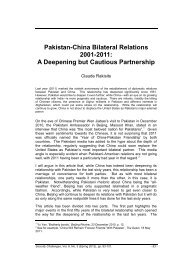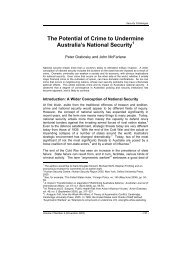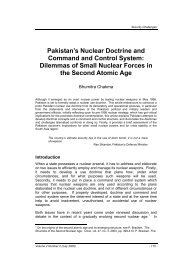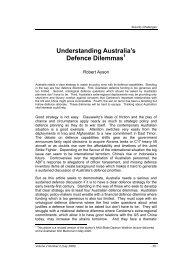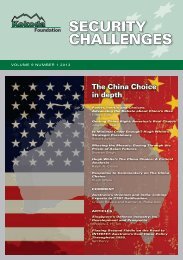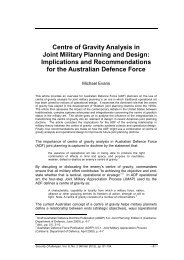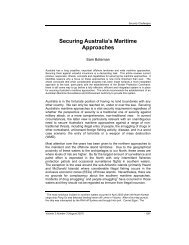The Transformation of Triad - Security Challenges
The Transformation of Triad - Security Challenges
The Transformation of Triad - Security Challenges
You also want an ePaper? Increase the reach of your titles
YUMPU automatically turns print PDFs into web optimized ePapers that Google loves.
Roderic Broadhurst and Lee King Wa<br />
nevertheless arrests for membership <strong>of</strong>fences are now less than a third <strong>of</strong><br />
the peak period post ICAC and subsequently continue to decline after the<br />
introduction <strong>of</strong> the Organised and Serious Crime Ordinance (OSCO) in 1994<br />
(see below).<br />
TRIADS:ORGANISATION AND VIOLENCE<br />
<strong>The</strong> role <strong>of</strong> violence, especially lethal violence, is a key feature <strong>of</strong> criminal<br />
groups and its use <strong>of</strong>fers one <strong>of</strong> the few windows into the nature <strong>of</strong> triads<br />
and the ‘control and command’ functions <strong>of</strong> such groups. Cressey’s<br />
(1969) 119 controversial portrayal <strong>of</strong> the mafia as a criminal organisation that<br />
monopolised racketeering through the centralisation <strong>of</strong> power (via measured<br />
use <strong>of</strong> violence and corruption to neutralise law enforcement) re-stimulated<br />
interest in the morphology <strong>of</strong> organised crime. 120 Others recognised that<br />
interdependent networks <strong>of</strong> criminal groups, flexible structure, fluid<br />
relationships between licit and illicit business enterprises, and the wider<br />
political–economic system reflected the complexity <strong>of</strong> organised and<br />
disorganised crime. 121 McIllwain for example, argued for a social network<br />
approach that ‘transcends’ and connects the dominant paradigms (i.e.<br />
organisational, patron-client and enterprise theories) that are <strong>of</strong>fered to<br />
explain organised crime. 122 Network theory partly overcomes the problem <strong>of</strong><br />
assuming ‘enterprise’ crime is centralised and that crime groups must be<br />
organised accordingly. <strong>Triad</strong>s tend to operate as franchise-like<br />
arrangements with members acting independently <strong>of</strong> the affiliation, although<br />
owing dues. 123<br />
<strong>The</strong> form <strong>of</strong> command and organisation in a crime group and the<br />
relationships with other crime groups bears on the effectiveness <strong>of</strong> control<br />
over the use <strong>of</strong> violence. Crime enterprises it might be assumed will seek to<br />
119 D. R. Cressey, <strong>The</strong>ft <strong>of</strong> the Nation: <strong>The</strong> Structure and Operations <strong>of</strong> Organized Crime in<br />
America (New York: Harper and Row, 1969).<br />
120 <strong>The</strong> 1985 New York ‘Commission’ case brought under the 1970 Racketeer Influenced and<br />
Corrupt Organizations Act showed that the five Mafia crime families based in New York enjoyed<br />
continuity and cooperated together in loose confederacy to minimise competition (and violence)<br />
and enhance stability and pr<strong>of</strong>its from their illicit enterprises: see J. B. Jacobs, C. Freil and R.<br />
Radick, Gotham Unbound (New York: New York University Press, 1999); S. Raab, Five<br />
Families (London: Robson, 2005).<br />
121 F. J. Ianni and R. E. Ianni, A Family Business: Kinship and Social Control in Organized<br />
Crime (New York: New American Library, 1973); Reuter and Rubinstein, ‘Fact, Fancy, and<br />
Organized Crime’; Smith, ‘Paragons, Pariahs, and Pirates: A Spectrum–Based <strong>The</strong>ory <strong>of</strong><br />
Enterprise’; Reuter, ‘<strong>The</strong> Decline <strong>of</strong> the American Mafia’. Illicit drug markets are essentially<br />
‘disorganised’ in the sense that most players have little influence over price and face constant<br />
competition.<br />
122 McIllwain, ‘Organized Crime: A Social Network Approach’ draws on J. Albanese, ‘Models <strong>of</strong><br />
Organized Crime’, R.J. Kelley, K.L. Chin and R. Schatzberg (eds.), Handbook <strong>of</strong> Organised<br />
crime in the United States (Westport, CT: Greenwood, 1994), pp 77-90; see also Morselli, Inside<br />
Criminal Networks.<br />
123 Chu, <strong>The</strong> <strong>Triad</strong>s as Business, Ip, ‘Organized Crime in Hong Kong’; J. McKenna, ‘Organised<br />
Crime in Hong Kong’, Journal <strong>of</strong> Contemporary Criminal Justice, vol. 12, no. 4 (1996), pp. 316-<br />
28. For further discussion especially the limitations <strong>of</strong> the enterprise approach and the broader<br />
social functions <strong>of</strong> mafia-like organised crime see Paoli, ‘<strong>The</strong> Paradoxes <strong>of</strong> Organized Crime’.<br />
- 18 - <strong>Security</strong> <strong>Challenges</strong>



